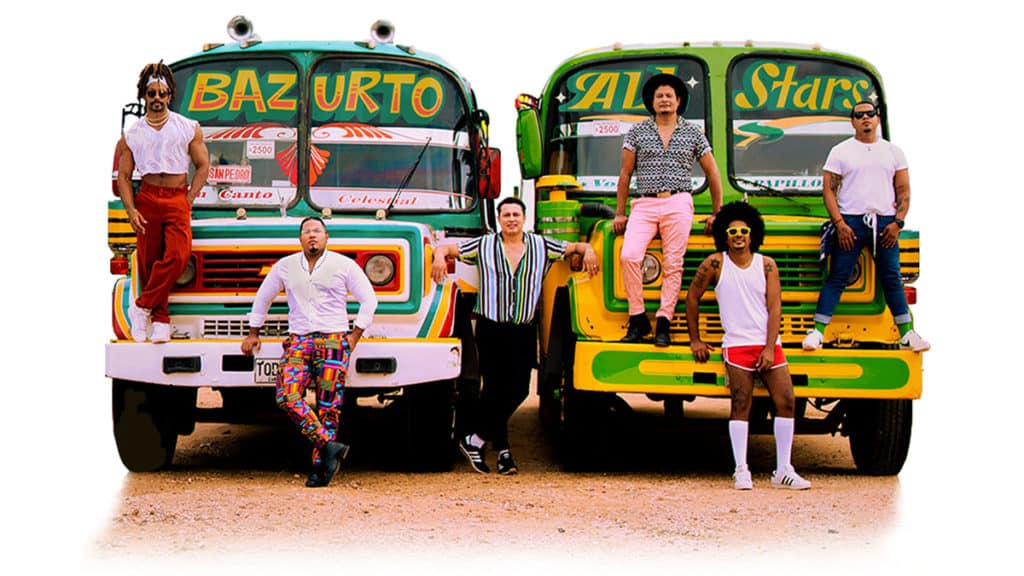The Bazurto All Stars are a Champeta fusion band from Cartagena, Colombia. They are the iconic band of the form.
Traditional Champeta is one thing. Champeta fusions bring influences from Colombian Cumbia & Vallenato, Jamaican Reggae & Ska, and European Classical Music because as Colombians, we are all that.
The Bazurto All Stars’ biggest hit is “La Pupileta” (2015) which became a hit across Colombia and the 2016 theme of Barranquilla Carnival, the world’s 2nd biggest carnival. African Diaspora culture and Carnival are deeply intertwined because in the Colonial Era, it was the only time we were allowed to celebrate our own traditions. The All Stars won the prestigious “Congo de Oro” award at Carnival three times.
A “pupileta” is a little student, a young pupil. The video is a humorous take on how elites often consider something to be low-class and too naughty, but once they learn it, they love it. That’s the universal story of Latin music.
Facebook @BazurtoAllStars
Instagram @bazurtoallstars
Bazurto All Stars in New York City
The Bazurto All Stars, the iconic Colombian Champeta band, make their New York debut with a performance preceded by a Champeta dance workshop at Flushing Town Hall in Flushing, Queens on Friday, September 30, 2022. Dance Workshop at 7pm. Show at 8pm. $18. Readers save 20% with code NYLAMAG at ovationtix.com 🇨🇴
The show is sponsored in part by: National Endowment for the Arts, New York State Council on the Arts, New York City Department of Cultural Affairs, Howard Gilman Foundation, Fan Fox and Leslie R. Samuels Foundation, Guru Krupa Foundation.
Cartagena is a Gem of the Caribbean
Bazurto is a neighborhood in Old Cartagena where bands at the Bazurto Social Club play Champeta on weekends. These are the All Stars of that community.
Cartagena is a Colombian Caribbean port with a beautiful colonial town center (1533) made famous in the Gabriel García Márquez novel, “Love in the Time of Cholera.” The UNESCO world heritage site is where Colombians go to party with family and friends, especially over the holidays.
The city is at the mouth of the Magdalena River, Colombia’s great river. It absorbs culture from across the country and across the Caribbean in the same way that New Orleans absorbs the culture of the Mississippi River watershed and the Caribbean. In fact, both Cartagena and New Orleans are Caribbean cities.
Champeta is an Afro-Colombian Dance
Champeta is a Colombian Caribbean dance that developed in Cartagena in the 1980s. It is derived from chalusonga, a 1970s dance from Palenque de San Basilio, the first free African Diaspora town in the Americas (1619). This is important because the Colonial narrative is that we just accepted colonization, but that’s not true. We fought back, escaped, and founded our own towns. Today, San Basilio is an important forge of Afro-Colombian culture. It even has its own Creole language, “Palenquero.”
The music and dance show influences of Kongo culture, one of the three African Diaspora cultural complexes that rooted in the Americas. Kongo culture comes from Central Africa in what are now the Congos and Angola. Kongo is strong in Brazil, but is everywhere in the Diaspora, especially in music.
Like all Latin music, Champeta was originally suppressed. Today it is a marker of Afro-Colombian identity and pride.
From our point of view as Puerto Rican drummers, we see many similarities with Bomba, and also with Cuban Rumba Columbia (the Rumba dance, not the country). The music sounds a lot like Fela Kuti’s Afrobeat which also mixed what was happening across the Americas into regional traditions. West African sailors brought Afrobeat records to the ports of Cartagena and Barranquilla in the 1970s. Different branches, same roots, and it all mixes together surprisingly well.
A “champeta” is literally a short machete. The word is derived from a racist slur used to insult the African Diaspora communities that settled around Cartagena. But we take everything bad we are given and turn it into good.
Another name for Champeta is “Terapía” (Therapy) because we use communal dance to let go of the sorrows of the day. This is a constant in Indigenous and African Diaspora traditions. For us social dance is therapy.
We wonder how to categorize Champeta. Is is Tropical Music? That’s Caribbean. Is it in the Cumbia & Vallenato frame? That’s Colombian. Is it Global Music like Fela Kuti’s Afrobeat? We think Champeta is all of the above. It’s a legacy of the incredible diversity that is Colombia, and the creativity of the African Diaspora.
Champeta culture has four elements (like Hip-Hops 4 elements):
- Music
- Language
- Picós sound systems
- Perreos dancing
And like Hip-Hop, Champeta is developing its own cultural universe. The most important thing to do when you sing and dance Champeta is smile!

